Unit 5 Do you have a soccer ball? SectionA 复习课件(共26张PPT)
文档属性
| 名称 | Unit 5 Do you have a soccer ball? SectionA 复习课件(共26张PPT) |  | |
| 格式 | zip | ||
| 文件大小 | 2.9MB | ||
| 资源类型 | 教案 | ||
| 版本资源 | 人教新目标(Go for it)版 | ||
| 科目 | 英语 | ||
| 更新时间 | 2021-10-26 22:26:02 | ||
图片预览

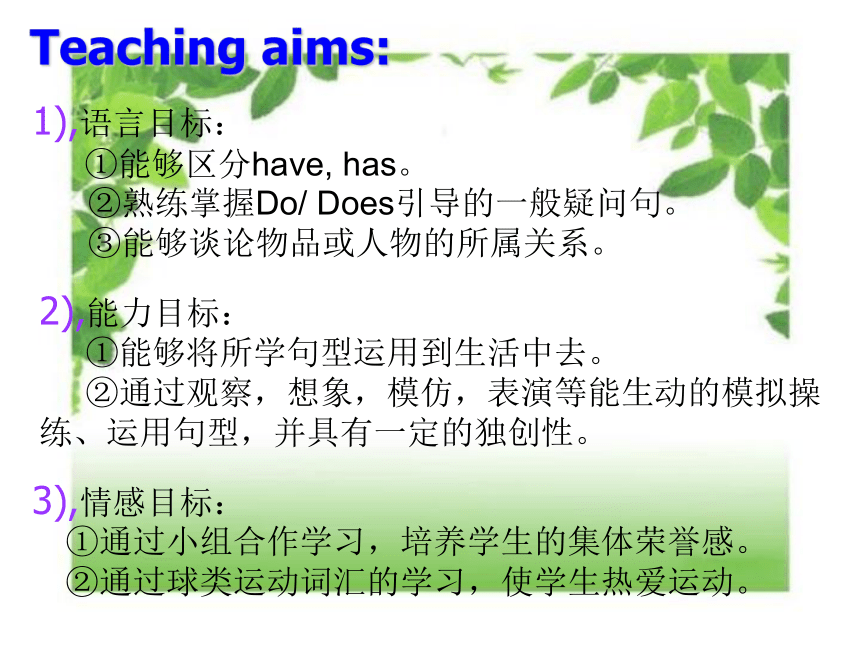
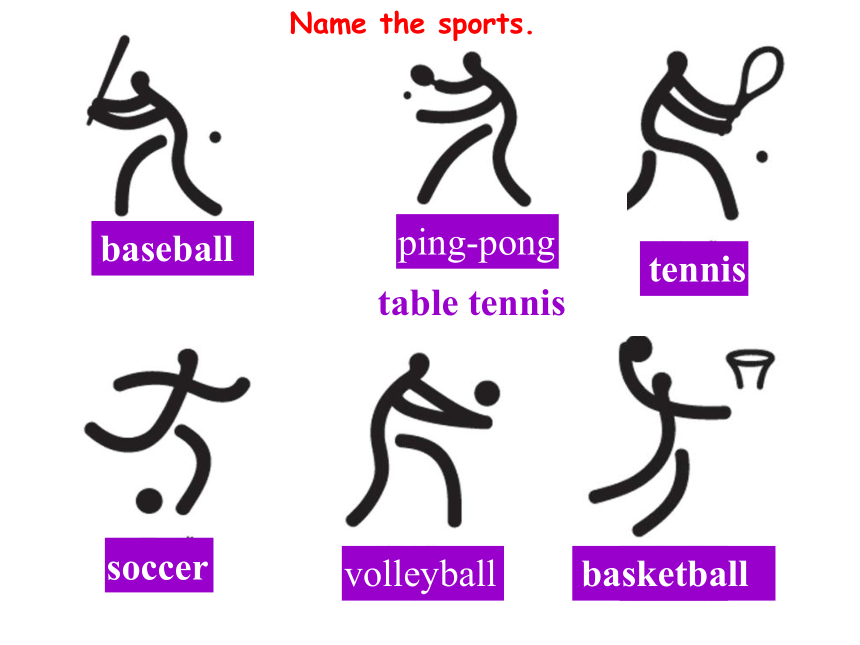

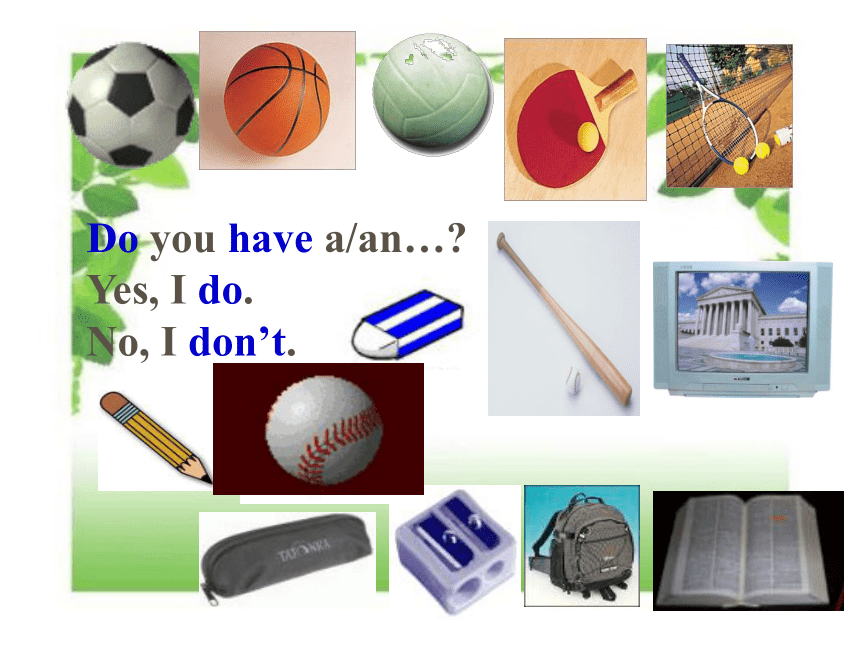
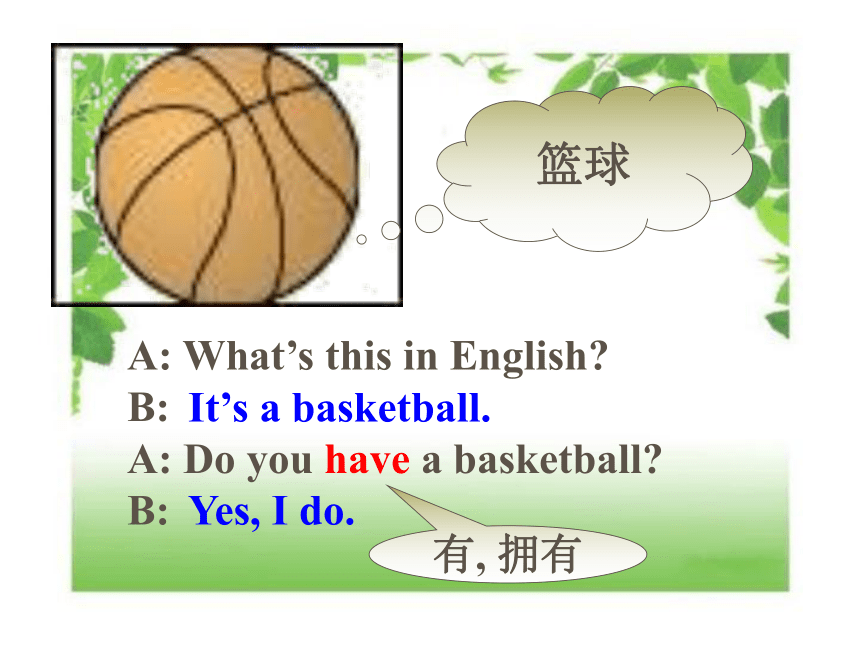
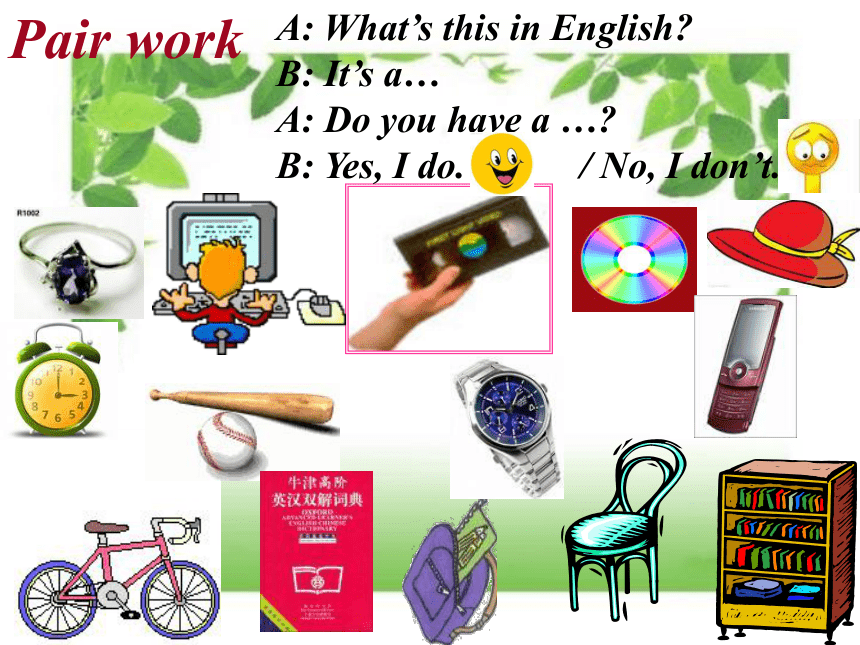
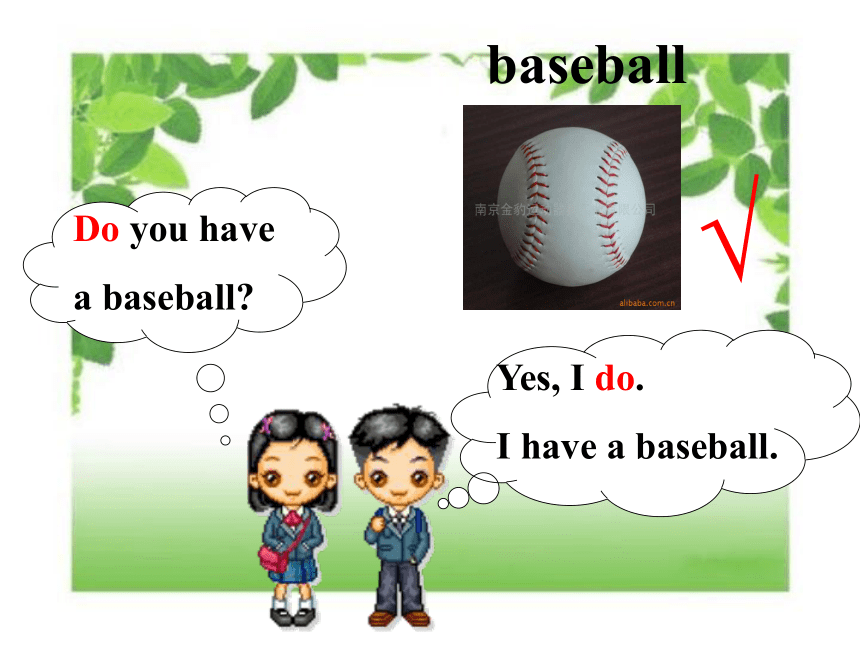
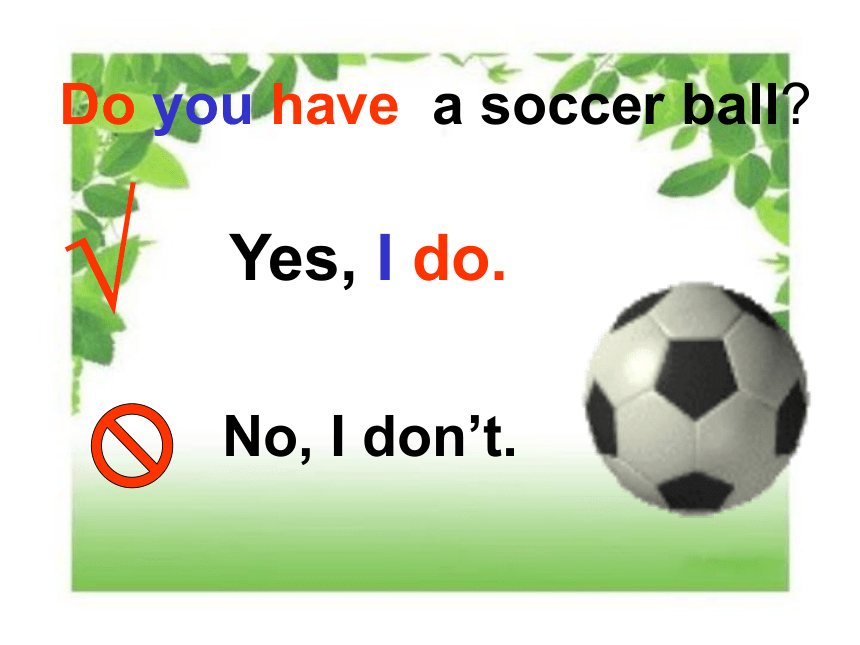
文档简介
(共26张PPT)
Teaching aims:
1),语言目标:
①能够区分have, has。
②熟练掌握Do/ Does引导的一般疑问句。
③能够谈论物品或人物的所属关系。
2),能力目标:
①能够将所学句型运用到生活中去。
②通过观察,想象,模仿,表演等能生动的模拟操 练、运用句型,并具有一定的独创性。
3),情感目标:
①通过小组合作学习,培养学生的集体荣誉感。
②通过球类运动词汇的学习,使学生热爱运动。
baseball
ping-pong
tennis
soccer
volleyball
basketball
Name the sports.
table tennis
basketball
soccer ball
volleyball
tennis ball
ping-pong ball
baseball
Do you have a/an…
Yes, I do.
No, I don’t.
A: What’s this in English
B:
A: Do you have a basketball
B:
It’s a basketball.
Yes, I do.
篮球
有, 拥有
A: What’s this in English
B: It’s a…
A: Do you have a …
B: Yes, I do. / No, I don’t.
Pair work
√
baseball
Do you have
a baseball
Yes, I do.
I have a baseball.
Do you have a soccer ball
√
Yes, I do.
No, I don’t.
Does she have a tennis ball
Yes , she does. She has a tennis ball.
soccer ball
Does he have a soccer ball
No, he doesn’t . He has a ping-pong bat.
Do they have a basketball
×
No, they don’t.
They have a volleyball.
A: ____you _____a _________
B: No, I don’t.
A: Do you have a _________
B: Yes, I do.
Look and say
Do
have
volleyball
soccer ball
A: _____he_____ a_________
B: Yes, _________.
A: ____she_____ a_________
B: No,___________.
Does
have
basketball
he does
Does
have
tennis ball
she doesn’t
A: ____you_____ a____________ and
a__________
B: No, ________.
Do
have
tennis racket
tennis ball
I don’t
Conclusion
助动词do/does用来构成否定句和疑问句,无实在意义。Do引导的一般疑问句,其结构为“Do+ 主语+have +其他?”。 该一般疑问句的肯定回答为:Yes, 主语+do;否定回答为:No,主语+don’t。
当主语为第三人称单数时,用does引导一般疑问句,肯定回答为: Yes, 主语+does;否定回答为:No, 主语+doesn’t 。如:
—Does she have a computer
— Yes, she does.
No, she doesn’t.
Jim
A: Does … have …
B: Yes, he/she does.
No, he/she doesn’t.
Kate
Pair work
Sally
Peter
Beckham
Summer
Mike
I have a TV.
I don’t have a TV.
Do you have a TV
Yes, I do. / No, I don’t.
He a ping-pong ball.
He have a ping-pong ball.
he have a ping-pong ball
Yes, he does. / No, he doesn’t.
doesn’t
has
Does
1. have “有,拥有”,它的第三人称单数是has
2. have与其它的词组合成词组、短语,就不表示 “有”了,其意思与后面的名词接近。如:
have classes (上课)
have breakfast (吃早饭)
have a good time (玩得高兴)
have sports (进行体育活动)
have a day off (休假)
3. have/has 与there be 二者都可译为“有”,但具体含义不同。
There be表示“在某地有某人或某物”,强调的是一种空间上的存在关系。结构为:
There be + 名词(人或物)+地点
have/ has表示“某人拥有某人或某物”,强调一种所属关系,即某人或某物属于主语所有。
人+ have/has+ 其它
There is a book on the desk.书桌上有一本书。
I have many books. 我有很多本书。
注意:当表示某物的构成或组成部分时,用there be
或have/has 均可以。
e.g. Our class has thirty students. =
There are thirty students in our class.
I ___ three friends in England.
2. They_____ a big room in China.
3. Mary ____ two cats.
4. Jack and Helen a son.
5. She ____ a big apple.
6.Do you a bag
7.Bob’s brother a nice watch.
8.Does Bob ______ a tennis
have
have
has
have
has
have
一、用 have or has 填空。
has
have
自 我 检 测
一、用have的适当形式填空
1. ____ you have a pen Yes, I ____.
2. ____they ____ apples No, they ____.
3. ____he ____ a basketball Yes, he____.
4. ____Amy ____ 5 eggs No,____ ____.
5. ____ Peter ____ a tennis ____,he doesn’t.
6. ____ the boys ___ a volleyball ____,_____ do.
7. ____ Jim and Alice ___ a computer
No,____ _____.
8.____ we ____ a soccer ball Yes,_____ ______.
.
Do
do
Do
have
don’t
Does
have
does
Does
have
she doesn’t
Does
have
No
Do
have
Yes they
Do
have
they don’t
Do
have
we do
have :
has :
do :
does:
I, you, we, they
he, she, it
总结
I you we they
he she it
说出肯否定回答.
Do you have a TV
Yes, I do. No, I don’t.
Do they have a computer
Yes, they do. No, they don’t.
Does he have a tennis racket
Yes, he does. No, he doesn’t.
Does she have a soccer ball
Yes, she does. No, she doesn’t.
Homework:
做对话:
A:Do you have a soccer ball
B:Yes,I do./ No, I don’t.
Teaching aims:
1),语言目标:
①能够区分have, has。
②熟练掌握Do/ Does引导的一般疑问句。
③能够谈论物品或人物的所属关系。
2),能力目标:
①能够将所学句型运用到生活中去。
②通过观察,想象,模仿,表演等能生动的模拟操 练、运用句型,并具有一定的独创性。
3),情感目标:
①通过小组合作学习,培养学生的集体荣誉感。
②通过球类运动词汇的学习,使学生热爱运动。
baseball
ping-pong
tennis
soccer
volleyball
basketball
Name the sports.
table tennis
basketball
soccer ball
volleyball
tennis ball
ping-pong ball
baseball
Do you have a/an…
Yes, I do.
No, I don’t.
A: What’s this in English
B:
A: Do you have a basketball
B:
It’s a basketball.
Yes, I do.
篮球
有, 拥有
A: What’s this in English
B: It’s a…
A: Do you have a …
B: Yes, I do. / No, I don’t.
Pair work
√
baseball
Do you have
a baseball
Yes, I do.
I have a baseball.
Do you have a soccer ball
√
Yes, I do.
No, I don’t.
Does she have a tennis ball
Yes , she does. She has a tennis ball.
soccer ball
Does he have a soccer ball
No, he doesn’t . He has a ping-pong bat.
Do they have a basketball
×
No, they don’t.
They have a volleyball.
A: ____you _____a _________
B: No, I don’t.
A: Do you have a _________
B: Yes, I do.
Look and say
Do
have
volleyball
soccer ball
A: _____he_____ a_________
B: Yes, _________.
A: ____she_____ a_________
B: No,___________.
Does
have
basketball
he does
Does
have
tennis ball
she doesn’t
A: ____you_____ a____________ and
a__________
B: No, ________.
Do
have
tennis racket
tennis ball
I don’t
Conclusion
助动词do/does用来构成否定句和疑问句,无实在意义。Do引导的一般疑问句,其结构为“Do+ 主语+have +其他?”。 该一般疑问句的肯定回答为:Yes, 主语+do;否定回答为:No,主语+don’t。
当主语为第三人称单数时,用does引导一般疑问句,肯定回答为: Yes, 主语+does;否定回答为:No, 主语+doesn’t 。如:
—Does she have a computer
— Yes, she does.
No, she doesn’t.
Jim
A: Does … have …
B: Yes, he/she does.
No, he/she doesn’t.
Kate
Pair work
Sally
Peter
Beckham
Summer
Mike
I have a TV.
I don’t have a TV.
Do you have a TV
Yes, I do. / No, I don’t.
He a ping-pong ball.
He have a ping-pong ball.
he have a ping-pong ball
Yes, he does. / No, he doesn’t.
doesn’t
has
Does
1. have “有,拥有”,它的第三人称单数是has
2. have与其它的词组合成词组、短语,就不表示 “有”了,其意思与后面的名词接近。如:
have classes (上课)
have breakfast (吃早饭)
have a good time (玩得高兴)
have sports (进行体育活动)
have a day off (休假)
3. have/has 与there be 二者都可译为“有”,但具体含义不同。
There be表示“在某地有某人或某物”,强调的是一种空间上的存在关系。结构为:
There be + 名词(人或物)+地点
have/ has表示“某人拥有某人或某物”,强调一种所属关系,即某人或某物属于主语所有。
人+ have/has+ 其它
There is a book on the desk.书桌上有一本书。
I have many books. 我有很多本书。
注意:当表示某物的构成或组成部分时,用there be
或have/has 均可以。
e.g. Our class has thirty students. =
There are thirty students in our class.
I ___ three friends in England.
2. They_____ a big room in China.
3. Mary ____ two cats.
4. Jack and Helen a son.
5. She ____ a big apple.
6.Do you a bag
7.Bob’s brother a nice watch.
8.Does Bob ______ a tennis
have
have
has
have
has
have
一、用 have or has 填空。
has
have
自 我 检 测
一、用have的适当形式填空
1. ____ you have a pen Yes, I ____.
2. ____they ____ apples No, they ____.
3. ____he ____ a basketball Yes, he____.
4. ____Amy ____ 5 eggs No,____ ____.
5. ____ Peter ____ a tennis ____,he doesn’t.
6. ____ the boys ___ a volleyball ____,_____ do.
7. ____ Jim and Alice ___ a computer
No,____ _____.
8.____ we ____ a soccer ball Yes,_____ ______.
.
Do
do
Do
have
don’t
Does
have
does
Does
have
she doesn’t
Does
have
No
Do
have
Yes they
Do
have
they don’t
Do
have
we do
have :
has :
do :
does:
I, you, we, they
he, she, it
总结
I you we they
he she it
说出肯否定回答.
Do you have a TV
Yes, I do. No, I don’t.
Do they have a computer
Yes, they do. No, they don’t.
Does he have a tennis racket
Yes, he does. No, he doesn’t.
Does she have a soccer ball
Yes, she does. No, she doesn’t.
Homework:
做对话:
A:Do you have a soccer ball
B:Yes,I do./ No, I don’t.
同课章节目录
- starters 预备篇(2012秋审查)
- Unit 1 Good morning !
- Unit 2 What’s this in English?
- Unit 3 What color is it ?
- Unit 1 My name's Gina.
- Section A
- Section B
- Unit 2 This is my sister.
- Section A
- Section B
- Unit 3 Is this your pencil?
- Section A
- Section B
- Unit 4 Where's my schoolbag?
- Section A
- Section B
- Unit 5 Do you have a soccer ball?
- Section A
- Section B
- Unit 6 Do you like bananas?
- Section A
- Section B
- Unit 7 How much are these socks?
- Section A
- Section B
- Unit 8 When is your birthday?
- Section A
- Section B
- Unit 9 My favorite subject is science.
- Section A
- Section B
